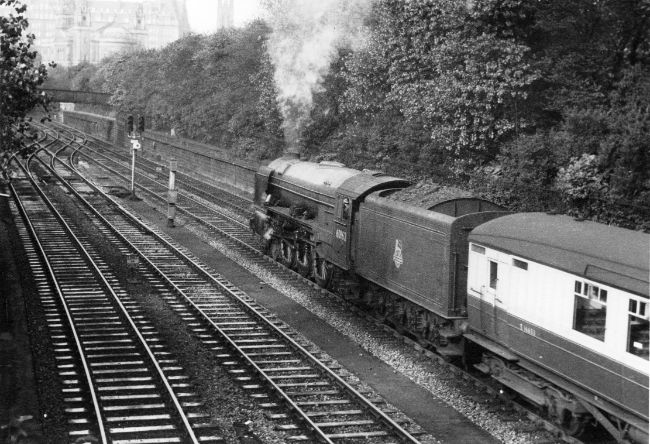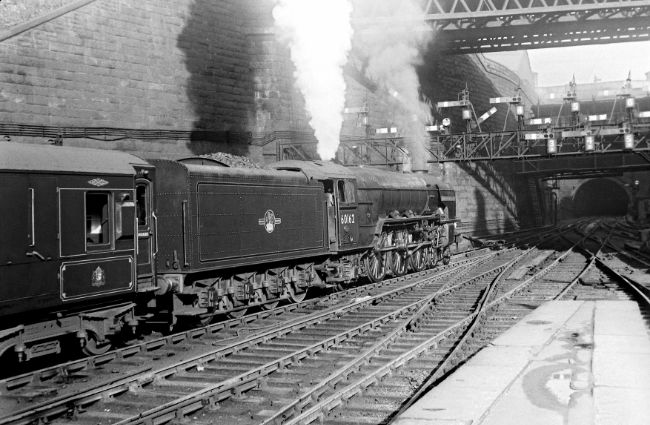Turned out of Doncaster on 23rd December 1949, No. 60162 was destined to be the last Peppercorn Class A1 Pacific to be completed until 2008! Built to works’ number 2056 and equipped with boiler No. 10599, the locomotive emerged from ‘The Plant’ in BR express passenger blue lined in black and white and bearing the early emblem on its tender. A Scottish locomotive for its entire career, No. 60162 was allocated to Haymarket shed (HAY) and was to remain there for almost its whole life. Quickly put to work on the northern section of the East Coast Main Line (ECML) it was soon working trains to Newcastle although its first recorded working of a named train was the up ‘Queen of Scots’ from Glasgow to Edinburgh on 23rd June 1951, shortly before it received non classified repairs at Cowlairs Works at the end of that month. No. 60162 returned to Doncaster for a heavy intermediate overhaul between 19th July and 21st August 1951, going through the paint shop of a coat of BR express passenger green paint, lined in black and orange with the early emblem on the tender as well as being fitted with its Saint Johnstoun nameplates (making it another A1 that never carried a name while in blue livery). The name refers to the city of Perth on the banks of the River Tay since during the later medieval period the city was also called St. John’s Toun or Saint Johnstoun by its inhabitants in reference to the main church dedicated to St John the Baptist. This name is preserved by the city’s football club, St. Johnstone F.C. and the city also featured in ‘The Fair Maid of Perth’ by Sir Walter Scott, published in 1828.

In early condition, Saint Johnstoun is seen at Princes Gardens, Edinburgh – Ian McDonald
Haymarket A1s were allocated regular drivers in the No. 2 Link, replacing A3s in that role, although the sixth engine remained Gresley Class A4 No. 60012 Dominion of New Zealand. Maintained by its regular driver, Willie Bain, to a very high standard and always immaculate, Saint Johnstoun worked all the former LNER main lines out of Edinburgh but rarely worked south of Newcastle but did find its way to Glasgow, Perth and Aberdeen. The locomotive was noted working the down ‘Heart of Midlothian’ from King’s Cross on 29th August 1951, probably following local running-turns after its overhaul, but failed while working the 22:20hrs ex-Edinburgh at Tweedmouth on 29th October 1952. The locomotive was back at Doncaster at the end of March 1953 for its first ‘General’ including a boiler change (boiler No. 29804), thereafter being recorded on the up ‘Heart of Midlothian’ on 6th July, taking the train to Newcastle and returning with the balancing service, and on the up ‘Queen of Scots’ on 21st August. No. 60162 visited ‘The Plant’ again in August 1954 when it received a lipped chimney and joined nine other A1s in having its Stones generator and electric lighting removed, ostensibly because of the cost of maintenance. On 4th September Saint Johnstoun was to be found working a local freight to Retford as far as York and then back on the 08:12hrs Newcastle-Cardiff service, both running-in turns after its stay at Doncaster, although they may have been rostered due to a shortage of power at York MPD that day! During October that year No. 60162 seems to have been the locomotive of choice for the up ‘Queen of Scots’, working the train on a number of dates, concluding the month by working the Royal Train between Newcastle and Edinburgh on the 30th at the conclusion of a royal tour of the West Riding of Yorkshire, Tyneside and on to Perth by HM the Queen and HRH the Duke of Edinburgh.

In final condition, No. 60162 leaves Glasgow Queen St. Station on 11th October 1959 – Peter Townend
East Coast duties pre-occupied Saint Johnstoun for much of the late ‘50s, often the up ‘Queen of Scots’ or ‘Heart of Midlothian’ or the down ‘Flying Scotsman’ only interrupted by calling at Doncaster for a general overhaul at the beginning of 1956 which involved having boiler No. 29803 fitted, light casual repairs during that April before working a freight train to King’s Cross East goods on 26th of that month as a running-in turn. After further ECML trains the locomotive was back at Doncaster for another general overhaul (boiler No. 29819 fitted) during September 1957 and again over Christmas 1958 (boiler No. 29874) before a change of direction in 1959, working trains over the Waverley Route to Carlisle and back, often the 04:04hrs Carlisle-Edinburgh or the 16:06 Carlisle-Edinburgh. However, 1960 brought a return to working trains to Newcastle and No. 60162 was often to be seen being serviced at Gateshead shed throughout that year, although the winds of change were starting the blow through depots on the ECML, with diesels, particularly ‘Deltics’ displacing express locomotives from the capital – despite this Saint Johnstoun was put through the works at Doncaster for a general overhaul during March 1960 (boiler No. 10596 fitted). One consequence of dieselisation was the drop in the cleaning standards of steam locomotives, even at Haymarket, and the A1s started to suffer from neglect, No. 60162 being photographed in filthy condition working an up Saturday extra on 15th July 1961 although it received its last ‘General’ and replacement boiler (No. 29813) as late as October 1961. The locomotive made minor history by turning up a Leeds Holbeck shed on 20th July 1962 having replaced a ‘Peak’ Class diesel that had failed on an overnight Scottish sleeper! Light repairs at Doncaster during March 1963 resulted in the locomotive working Doncaster-Leeds and Leeds-Doncaster locals on the 14th as running-in duties and after that it worked increasingly few frontline trains, being used on freight and parcels traffic. The glory days were not quite over, however, and on 14th May Saint Johnstoun worked the up ‘Bon Accord’ and returned with the down ‘St. Mungo’, its last recorded named trains. The inevitable was coming though and, on 9th September 1963 the locomotive was transferred to St. Margarets shed (64A), in the company of Nos. 60159 Bonnie Dundee, 60160 Auld Reekie and 60161 North British, to be officially withdrawn on 28th October. After a few month’s storage, the locomotive was moved to Inverurie Works and cut up in February 1964 after a working life of just 13 years ten months and five days having carried a total of seven diagram 118 boilers.
This history was compiled by Graham Langer based on a database compiled by Tommy Knox, with reference to the RCTS book ‘Locomotives of the LNER Part 2A’ and ‘Yeadon’s Register of LNER Locomotives’ as background.